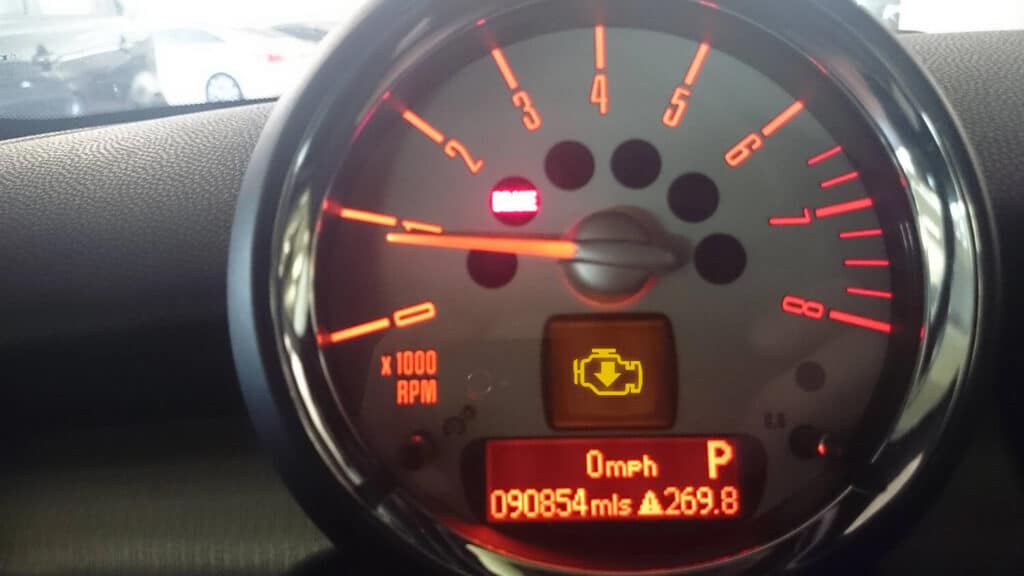Revving Up Your Knowledge on the Reduced Power Check Engine Light
Imagine you’re on the open road, wind in your hair, when suddenly, a warning light flickers on your dashboard. It reads: “Reduced Engine Power.” A wave of dread washes over you. Is your car about to give up the ghost right here and now? Take a breath; this guide aims to empower you with the knowledge to tackle this situation head-on.
The Illuminating Beacon: Understanding the Reduced Power Check Engine Light
The “Reduced Engine Power” warning light is like your vehicle’s way of waving a red flag, signaling that something’s not right under the hood. Unlike other dashboard lights that might merely suggest routine maintenance, this light has a sense of urgency attached to it. In the automotive world, this warning light serves as a caution tape that cordons off a problem area—your engine, in this case.
What does it actually mean when this light comes on? Essentially, your car has sensed that its engine or related systems are not operating at their optimal levels. It’s an intelligent preemptive measure, somewhat like your body running a fever to fend off infection.
The bottom line is this: when the “Reduced Engine Power” light comes on, your vehicle is not crying wolf. While it may not require you to pull over and stop driving instantly, it does mean you should plan a trip to a professional mechanic as soon as feasible. The longer you ignore it, the higher the chances that this warning light will lead you down a road paved with more severe problems and higher repair costs.

Code Red Scenarios: Causes That Trigger the Light
• Faulty Throttle Body: One of the more common triggers, a malfunctioning throttle body can impede the proper flow of air into your car’s engine. This compromises performance and can activate the warning light.
• Worn-Out Spark Plugs: Over time, spark plugs can wear out or become fouled, causing misfires and reducing engine power. This is often a more straightforward and less expensive fix.
• Oxygen Sensor Failure: A faulty oxygen sensor can send incorrect data to the vehicle’s computer, impacting the air-to-fuel ratio and leading to reduced engine power.
• Bad Fuel Pump: If your car isn’t getting the fuel it needs, the engine can’t operate efficiently. A failing fuel pump is often a culprit in reduced engine power scenarios.
• Compromised Catalytic Converter: This part filters harmful substances from your vehicle’s exhaust. If it’s not working correctly, this can create back pressure in the exhaust system, leading to performance issues.
• Corroded or Loose Wiring: Electrical issues can also cause reduced engine power. Damaged or corroded wiring can lead to poor signals between the electronic control unit (ECU) and the engine components.
• Software Glitches: Sometimes, the issue might not be mechanical at all. Software issues can also trigger the “Reduced Engine Power” warning. These can often be resolved through a system reset or software update.
• Dirty or Clogged Air Filter: A restricted air flow can hamper engine performance, leading to potential reduced power warnings.
• Malfunctioning Mass Air Flow Sensor: This sensor monitors how much air enters the engine. A malfunction could lead to an incorrect air-to-fuel ratio, triggering the warning light.
• Transmission Issues: Though less common, problems with the transmission can also activate the reduced engine power light, especially if they lead to irregularities in power distribution.
It’s essential to diagnose the root cause to correct it, avoiding further damage or, worse, a total breakdown.
The Roadside Experience: What ‘Reduced Engine Power’ Feels Like
It’s an experience akin to running a marathon with a weighted backpack. Your vehicle, usually nimble and responsive, starts to feel sluggish and unresponsive. When the “Reduced Engine Power” warning light flickers on, it’s as if your car suddenly contracted the flu—there’s a noticeable lethargy in its movements.
You’ll sense an immediate and palpable decrease in your car’s acceleration. Pressing the gas pedal feels like stirring a spoon through thick molasses. You don’t get the immediate punch of speed you’re used to. This can be unnerving, especially if you’re on a busy road with vehicles zooming past you.
Secondly, the throttle response goes from eager to indifferent. In normal conditions, the throttle response is crisp; you step on the gas and the car leaps forward. But in reduced engine power mode, it’s more like a sleepy nod rather than a sprightly jump. The connection between your foot on the pedal and the car’s speed becomes increasingly disconnected, leaving you feeling out of control.
Don’t be surprised if you hear or feel a change in the engine’s rhythm. The roar might turn into a murmur as the vehicle’s onboard computer limits various performance parameters to prevent further damage. It’s a call to action, signaling that you need to be cautious and seek professional help to diagnose the issue.
Traffic Lights and Caution Signs: Is It Safe to Drive?
• Reduced Acceleration: One of the most noticeable changes when the “Reduced Engine Power” light comes on is limited acceleration. You may struggle to get your vehicle up to an appropriate speed, making merging onto highways or even keeping pace in regular traffic hazardous.
• Unpredictable Behavior: Your car may become sluggish or hesitate when you press the gas pedal. This unpredictability can be dangerous, especially in high-traffic situations or during maneuvers like overtaking.
• Limited Vehicle Control: The reduced power affects not just speed but also the overall maneuverability of the vehicle. Quick turns, sudden stops, and even steady cruising can become challenging and stressful.
• Immediate Action Required: If this warning light comes on, the safest course of action is to pull over at the earliest opportunity. Continuing to drive with the warning light on increases the risk of a breakdown or even an accident.
• Consult Professional Help: Even if the light turns off after restarting the vehicle, this should only be considered a temporary reprieve. A mechanic’s diagnosis is essential for pinpointing and solving the underlying issue.
Mechanic’s Toolbox: Potential Repairs and the Cost Roadmap
• Throttle Body Replacement: One of the most common causes for a “Reduced Engine Power” warning is a malfunctioning throttle body. Replacing this part could cost you anywhere between $200 to $600, depending on your vehicle’s make and model.
• Sensor Repairs: Faulty sensors, like the throttle position sensor or the mass airflow sensor, may also trigger the warning. Costs for sensor replacements can range from $100 to $300.
• Computer Reset: Sometimes, the issue might be as simple as a computer glitch that can be fixed by resetting the vehicle’s onboard computer. This is often a no-cost solution but should be verified by a professional to ensure there are no underlying issues.
• Wiring and Electrical Fixes: Damaged wiring or poor electrical connections can also cause the warning light to appear. Repair costs here can vary widely, from $50 for minor fixes to several hundred for more complex electrical work.
• Labor Costs: In addition to parts, you’ll also need to consider labor costs, which can range from $50 to $100 per hour, depending on where you get the service.
• Diagnostic Costs: Expect to pay around $50-$100 for a complete diagnostic test to identify the cause of the “Reduced Engine Power” light. Some mechanics might waive this fee if you choose to get the repair work done at their shop.
• Wide Cost Range: Due to the diverse range of potential issues, it’s challenging to give an exact cost estimate without a professional diagnosis. The financial burden could be minimal or run into the hundreds, emphasizing the need for immediate professional attention.

Roadside Assistance: How to Get Your Car Back to Full Throttle
Your car’s computerized system may sometimes require a ‘soft reset’ to clear any transient faults. For the non-mechanically inclined among us, here are some immediate steps to try:
• Turn Off and Restart: Pull over safely and turn off your engine. Take a deep breath to calm your nerves. Wait a few minutes before restarting the car. This action can sometimes clear minor glitches and may turn off the warning light. However, note that this is more of a band-aid than a cure.
• Check for Obvious Faults: Sometimes, a loose gas cap or visibly damaged wire could be triggering the sensor. A quick visual inspection might give you clues.
• Consult Your Owner’s Manual: The owner’s manual is a treasure trove of information. Find the section about warning lights to see if there are any manufacturer-recommended immediate actions.
• Use a Diagnostic Tool: If you happen to carry an OBD-II (Onboard Diagnostic) scanner in your glove compartment, now’s the time to plug it in. These devices can provide a diagnostic code that points to the problem. There are even smartphone apps that can read these codes.
• Call for Help: If the light persists and you’re not confident in your mechanical skills, it’s wise to call for roadside assistance or a tow service. You could also reach out to friends or family who might have some mechanical expertise.
Remember, these are only immediate, makeshift solutions to get you out of a tight spot. They don’t replace the diagnostic expertise of a skilled mechanic. And if you find yourself frequently resorting to these steps, consider it a red flag that something needs a more in-depth look. By taking these immediate measures, you could potentially save yourself from being stranded in a less-than-ideal location, buying you time until you can consult a mechanic for a thorough diagnosis and repair.
Empowering Your Drive — How to Maneuver Engine Power Pitfalls
While a “Reduced Engine Power” warning is no picnic, arming yourself with knowledge is the first step in troubleshooting and, ultimately, resolving the issue. When in doubt, the smart move is always to consult a professional. And speaking of pros, if you’re in Canada and find yourself in a jam, Uchanics mobile mechanic services can swoop in to save the day. They’ll tackle your engine woes and get you back on the road, empowering you to navigate future engine pitfalls like a seasoned pro.
Ready to get your car back to peak performance? Head over to Uchanics to book an appointment.
